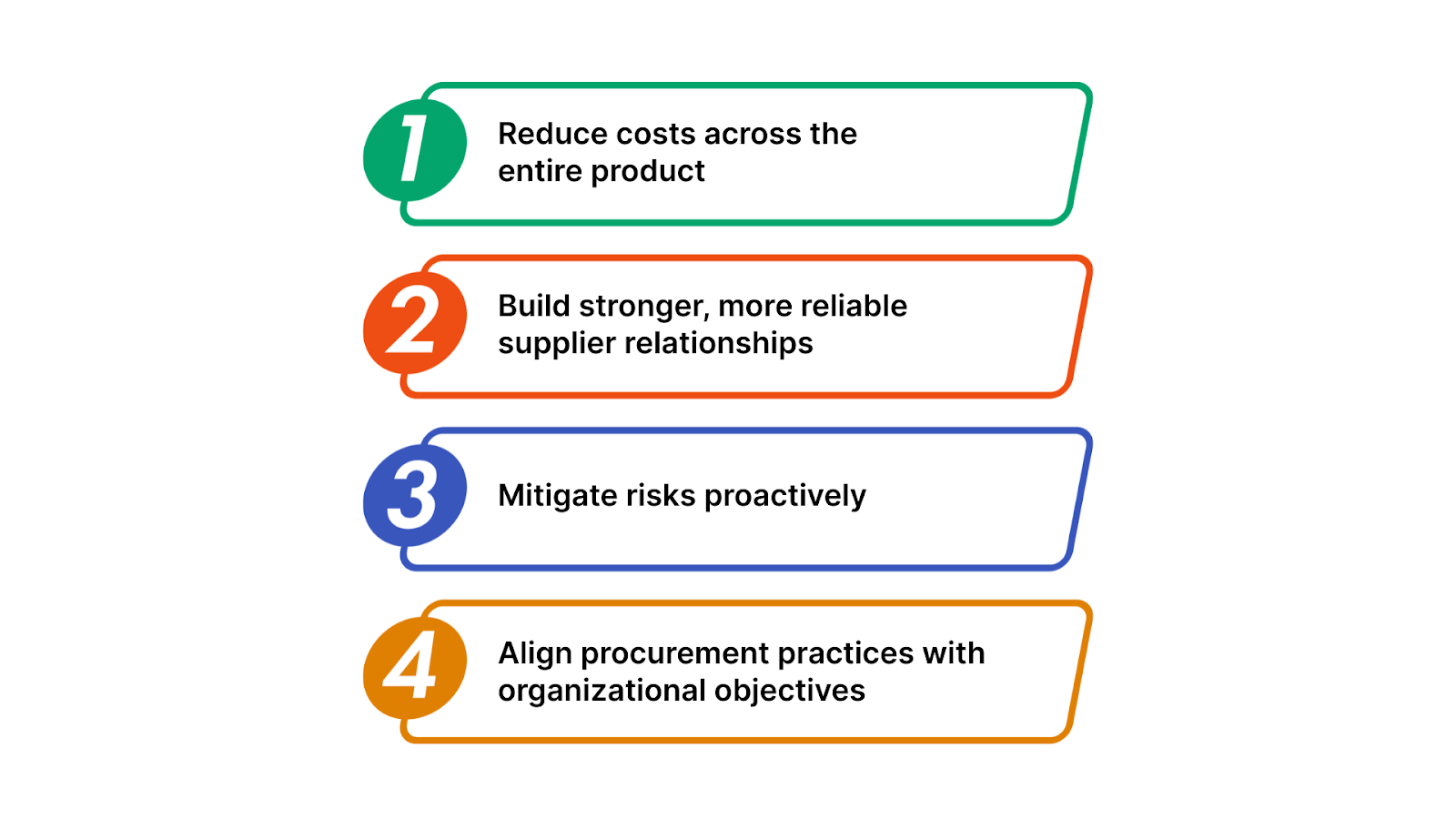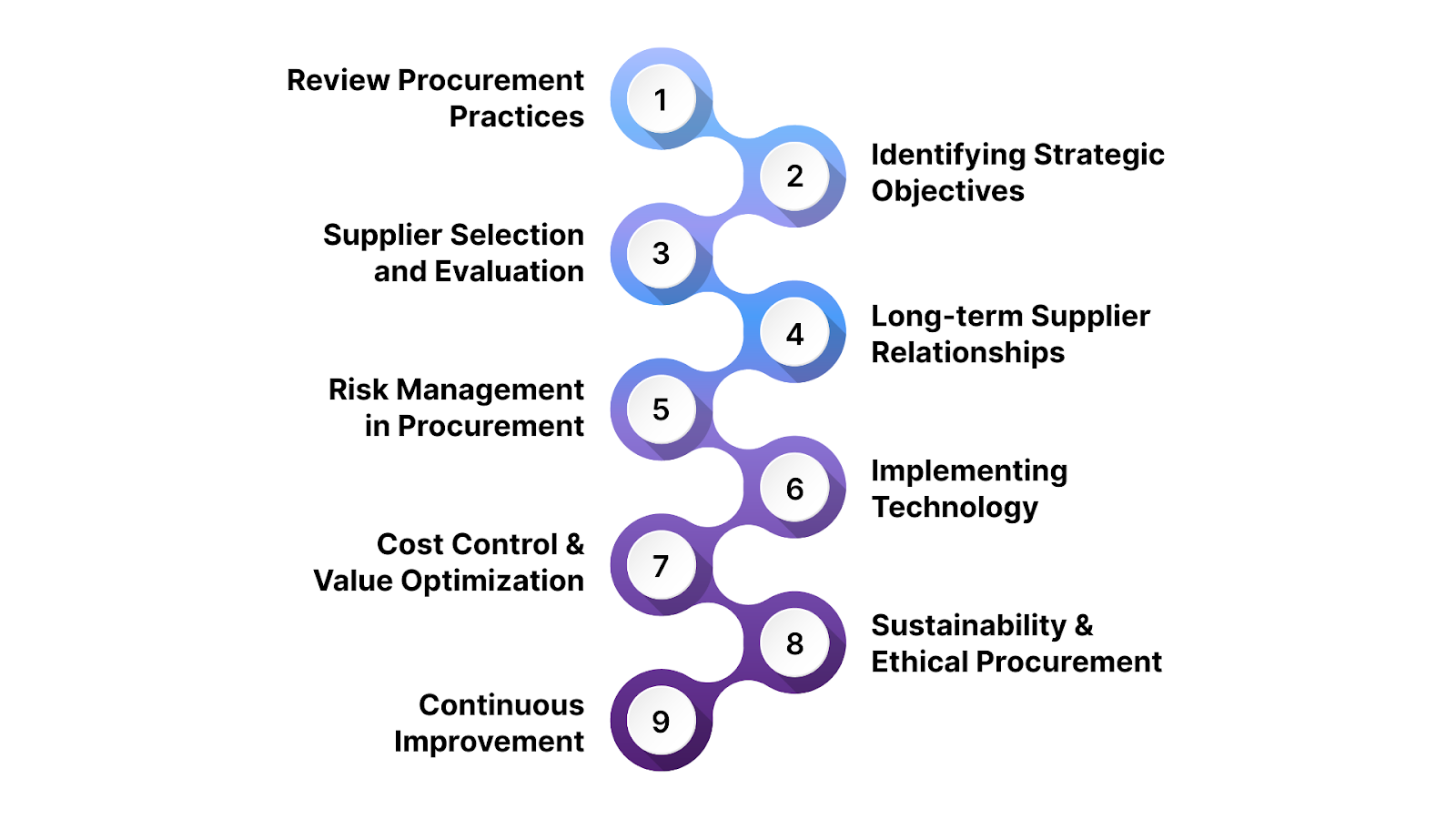
When you think of procurement, you might envision purchase orders, price negotiations, and strict cost-saving targets. However, this perspective overlooks the broader strategic role procurement plays in modern organisations. Strategic procurement transcends routine transactions; it transforms purchasing into a competitive advantage that drives long-term value.
In Saudi Arabia, the procurement-as-a-service market revenue is about SAR 539.25 million in 2024 and is projected to reach approximately SAR 2,035.13 million by 2033, growing at a CAGR of 16.5%.
This blog will delve into what makes procurement "strategic," why it matters for your organisation, and provide a step-by-step guide to implementing it effectively.

Unlike traditional procurement, which often focuses on short-term cost savings and transaction processing, strategic procurement is a holistic approach.
It involves analyzing your current practices, setting long-term goals, building strong supplier partnerships, and embedding technology and sustainability into every stage of the process.
By implementing strategic procurement, you:
With the big picture in mind, the next step is to look inward and assess your current procurement practices.


Before you can chart a new course, you need to understand your starting point. In this step, you’ll evaluate your existing procurement processes, identify challenges, and consider the unique context of Saudi Arabia.
Once you’ve mapped out where you are, it’s time to define where you want procurement to take you.
Strategic objectives may include improving supplier relationships, ensuring compliance, driving sustainability, reducing risks, or supporting organisational growth. Setting clear objectives aligns procurement with broader business goals and provides a roadmap for decision-making.
With clear goals in place, the next step is selecting suppliers who can help you achieve them.
Choosing the right suppliers is at the heart of strategic procurement. At this stage, the focus shifts to identifying the right suppliers who can deliver value, reliability, and long-term partnership potential. It involves evaluating suppliers based on criteria such as quality, pricing, compliance, risk profile, capacity, and alignment with sustainability goals.
Once you’ve selected the right suppliers, the next step is to shift from transactions to partnerships.
Supplier relationships can make or break your procurement strategy. In this step, you’ll explore how to foster long-term, collaborative partnerships that go beyond simple transactions.
Building on the foundation of strong supplier relationships, the next critical step is ensuring that your procurement strategy remains resilient in the face of potential disruptions.
Every procurement process carries risks. This section explains how to identify potential hazards, develop strategies to mitigate them, and address specific risks faced in Saudi Arabia.
While managing risks is vital, leveraging technology can take your procurement function to the next level.
Technology is a game-changer in procurement. This step is about integrating modern solutions to streamline procurement processes, improve transparency, and enhance decision-making. Digital tools such as e-procurement platforms, ERP systems, and data analytics enable automation of repetitive tasks, better supplier management, and real-time tracking of performance.
Technology can increase efficiency, but you also need strong strategies for controlling costs and maximizing value.
HAL stands out as a leading technology partner in Saudi Arabia, offering advanced e-procurement, automation, data analytics, and supplier management platforms. HAL streamline procurement processes by automating routine tasks and providing real-time, data-driven insights that enhance decision-making.
Cost is always central to procurement, but the strategic approach focuses on total value. In this step, you’ll explore negotiation strategies, total cost of ownership, and cost considerations in Saudi Arabia.
Effective cost control in procurement goes beyond simple price negotiation; it helps in optimizing the total cost of ownership through automation and real-time insights. HAL’s advanced procurement platform empowers organisations with dynamic cost optimization tools that provide actionable, up-to-the-minute data on spending patterns, supplier performance, and market fluctuations.
Procurement today must balance financial goals with social and environmental responsibility. This step focuses on integrating sustainability into procurement by choosing eco-friendly suppliers, promoting ethical practices, and reducing environmental impact.
As you focus on sustainability, the next step is to ensure ongoing optimization and evaluation of procurement practices to maintain long-term success.
Procurement is an evolving function. In this step, you’ll learn how to monitor, evaluate, and improve procurement practices continually, especially in a dynamic market like Saudi Arabia.
While these strategic procurement steps strengthen internal efficiency, aligning them with national objectives like Saudi Arabia’s Vision 2030 takes procurement excellence to a whole new level.
Also Read: Cost-Effective Procurement Management: How Software Can Help?
As part of Saudi Arabia's Vision 2030 initiative, companies like SABIC, STC, and NEOM are leading the way in strategic procurement that aligns with national development goals. These organisations have adopted procurement strategies that not only drive business growth but also contribute to the Kingdom’s transformation into a more diversified and sustainable economy.
Case Study: NEOM and Strategic Procurement
NEOM, one of the flagship projects under Vision 2030, is building a smart, sustainable city that requires cutting-edge procurement practices to ensure the delivery of world-class infrastructure and technology.
The city’s procurement strategy focuses on aligning supplier partnerships with the Kingdom’s sustainability goals and fostering innovation. By strategically sourcing local suppliers, NEOM is contributing to the growth of the Saudi supply chain, ensuring high standards of compliance, and supporting the Vision’s local content requirements.
Strategic Procurement Steps at NEOM:
This case study illustrates how large-scale procurement projects aligned with Vision 2030 goals can enhance supply chain resilience, ensure compliance with Saudi regulations, and deliver substantial value to the nation’s development.
Now that you understand the steps, let’s explore how HAL can support you in putting them into action.

Technology and expertise are essential to implementing strategic procurement effectively. This section highlights how HAL’s advanced tools and platforms can support each step of your journey.

Strategic procurement today goes far beyond cost savings. It is about building long-term value, reducing risks, and forging supplier partnerships that strengthen resilience. By assessing current practices, aligning procurement with broader business goals, and embracing technology, you can transform procurement from a transactional process into a competitive advantage.
With HAL ERP, this shift becomes more practical and measurable. The platform enables automation, risk monitoring, and seamless supplier collaboration, helping organisations align procurement practices with long-term strategies such as Saudi Arabia’s Vision 2030. This ensures procurement contributes meaningfully to overall growth and efficiency.
Discover how HAL ERP can enhance your procurement operations and deliver strategic value. Book a demo with HAL ERP today to start building a more resilient and future-ready procurement function.
1. What is strategic procurement, and why is it important?
Strategic procurement aligns purchasing activities with broader business goals, enabling organisations to optimize costs, improve supplier performance, mitigate risks, and achieve sustainability objectives.
2. How does strategic procurement differ from traditional procurement?
Traditional procurement focuses mainly on transactional tasks and immediate cost savings, while strategic procurement adopts a holistic, long-term perspective. It emphasizes risk management, technology integration, and alignment with organisational strategies.
3. Why is supplier relationship management important?
Effective supplier relationship management fosters collaboration and trust, which leads to innovation, smoother supply continuity, and better risk mitigation. Strong partnerships reduce costs over time and provide greater flexibility during market disruptions.
4. How can procurement in Saudi Arabia benefit from Vision 2030?
Vision 2030 encourages localization, sustainability, and digital transformation, which enhance supply chain resilience and competitiveness. Strategic procurement aligned with these goals supports economic diversification and compliance with regulatory mandates.
5. What role does technology play in strategic procurement?
Technology automates repetitive tasks, improves data accuracy, and provides real-time insights for smarter decision-making. E-procurement, analytics, and ERP systems like HAL enable more efficient workflows, risk monitoring, and cost optimization, empowering procurement teams to focus on value creation.